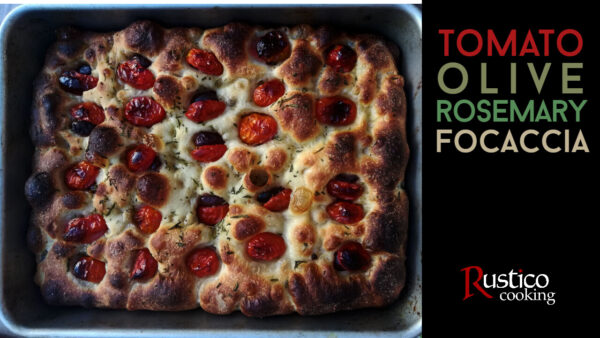| |
You can determine the thickness of the baked focaccia by flattening it more or less before baking; the dough will roughly double in the oven, so use that as a guide to how flat you want to make it prior to baking. Select a baking sheet that allows you to stretch the dough out to your liking; a small baking sheet will constrict how much you can flatten the dough. I find a baking sheet measuring 11-inches x 17-inches (28 centimeters x 44 centimeters) is ideal.
We are not fans of yeasted doughs that rise quickly in a hot environment, relying on more yeast and less time to get the dough in the oven fast, where they then puff up uncontrollably. The recipe we have developed uses a small amount of yeast and a long, cool rise in the refrigerator to yield a focaccia with deep, wheaty flavor; it may seem like 1/2 teaspoon of yeast isn’t enough to get the dough to rise, but trust me—it works, as long as you give the dough enough time.
Most importantly, remember to watch the dough and not the clock; if the kitchen is cold, the dough will take longer to rise, so be patient. I cannot tell you how many emails I get from panicked home bakers saying their dough didn't rise, and when asked, they say the room is cold and it's only been a few hours... Again, watch the dough, not the clock, and allow for more time to rise in the cool months. TOTAL TIME: 24 hours (including overnight rising of dough)
ACTIVE TIME: 30 minutes Serves 2 as a main course, 4 to 6 as bread
FOR THE DOUGH:
500 grams (1 pound 2 ounces) unbleached all-purpose flour (we suggest King Arthur)
1/2 teaspoon instant yeast (we suggest SAF Yeast)
10 grams (2 teaspoons) fine sea salt
10 grams (2 teaspoons) extra-virgin olive oil
350 grams (12 ounces) water at room temperature (around 78°F), plus extra as needed
FOR THE TOPPING:
60 grams (2 ounces) extra-virgin olive oil, plus extra for brushing
½ teaspoon sea salt
2 tablespoons minced fresh rosemary
24 pitted black olives, halved
24 grape tomatoes, halved
- Place the flour, yeast, and salt in a large bowl. Mix thoroughly with your hands or a spoon to distribute the yeast.
- Add the oil and all but 30 grams (1 ounce) of the room temperature water, mixing with a spoon all the while. The dough should come together nicely. If it seems dry, add the remaining water as needed by the teaspoon; if it seems sticky, add flour by the teaspoon. It is best to hold back a little water from the suggested amount at first when mixing because different flours absorb different amounts of water. Some flours may even need more water, so just trust your hands and adjust as necessary.
- Use your hands to knead the dough in the bowl for 2 minutes, or until the dough smooths out and the flour is thoroughly hydrated. The dough should have the texture of an earlobe: soft and pliable, yielding to pressure. Place in a clean bowl and cover with plastic wrap.
- During the first hour of rising time, do 3 or 4 sets of stretch and folds to develop strength in the dough. Stretching and folding redistributes the yeast cells throughout the dough as it ferments and equalizes dough temperature during fermentation.
- To stretch and fold dough, think of your dough as being divided into North-South-East-West quadrants. Pick up the side corresponding to North and fold it over to the South. Then pick up the side corresponding to the East and fold it over to the West. Then pick up the side corresponding to the South and fold it over to the North. Finally, pick up the side corresponding to the West and fold it over to the East. Place seam side down in the bowl and cover again.
- Let the dough sit at room temperature until it rises by 50% of its original volume, about 1 to 2 hours at 80°F (it will take about 6 hours at 72°F, longer at cooler temperatures), then refrigerate for 1 to 3 days. Note: If the room is cold, the dough will take longer to rise by 50%. Watch the dough, not the clock.
- The dough will continue to rise slowly in the refrigerator. The goal is for the dough to slowly double in the refrigerator; if your refrigerator is warm, the dough will ferment more quickly, so you will need to fold it over itself to redistribute the yeast in this case. To fold the dough: deflate it by folding it over itself once or twice, then cover again and refrigerate until 2 hours before baking. The dough should never rise to more than double.
- About 2 hours prior to baking, take the dough out of the refrigerator.
- Take a piece of parchment paper and lightly oil it. Place the parchment paper on a large baking sheet; 11-inches x 17-inches (28 centimeters x 44 centimeters) is good, but smaller or bigger works too. Ideally, the parchment paper should hang slightly over the sides of the baking sheet to facilitate retrieval later. Be sure there isn’t any oil on the exposed parts of the parchment paper or you will risk a fire in the oven.
- Place the dough on the parchment paper and pre-shape gently into a round; it should be about 1 and 1/2 inches (4 centimeters) thick. Rub with the olive oil and top with a loose piece of plastic wrap, or an inverted bowl or container lid. Let rise until almost doubled at room temperature; this will depend on your room temperature, about 2 hours around 78°F.
- One hour before baking, preheat the oven, with a stone in it, to 425°F convection or 450°F regular.
- When you are ready to bake, uncover the dough. Dimple and stretch the dough out until about 1/2-inch (1.3 centimeters) thick to 3/4-inch (2 centimeters) thick. How much you flatten the dough depends how high you want the focaccia: it will double in the oven. Dimple again with your fingertips and rub generously with the olive oil.
- Season with the salt. Scatter the rosemary over the dough. Top with the olive halves. Cover each olive half with a tomato half (this prevents burning).
- Bake, still on the baking sheet with the parchment paper on the stone, until golden and speckled with brown, about 18 to 20 minutes, rotating as needed. Brush with olive oil and serve.
|
|


